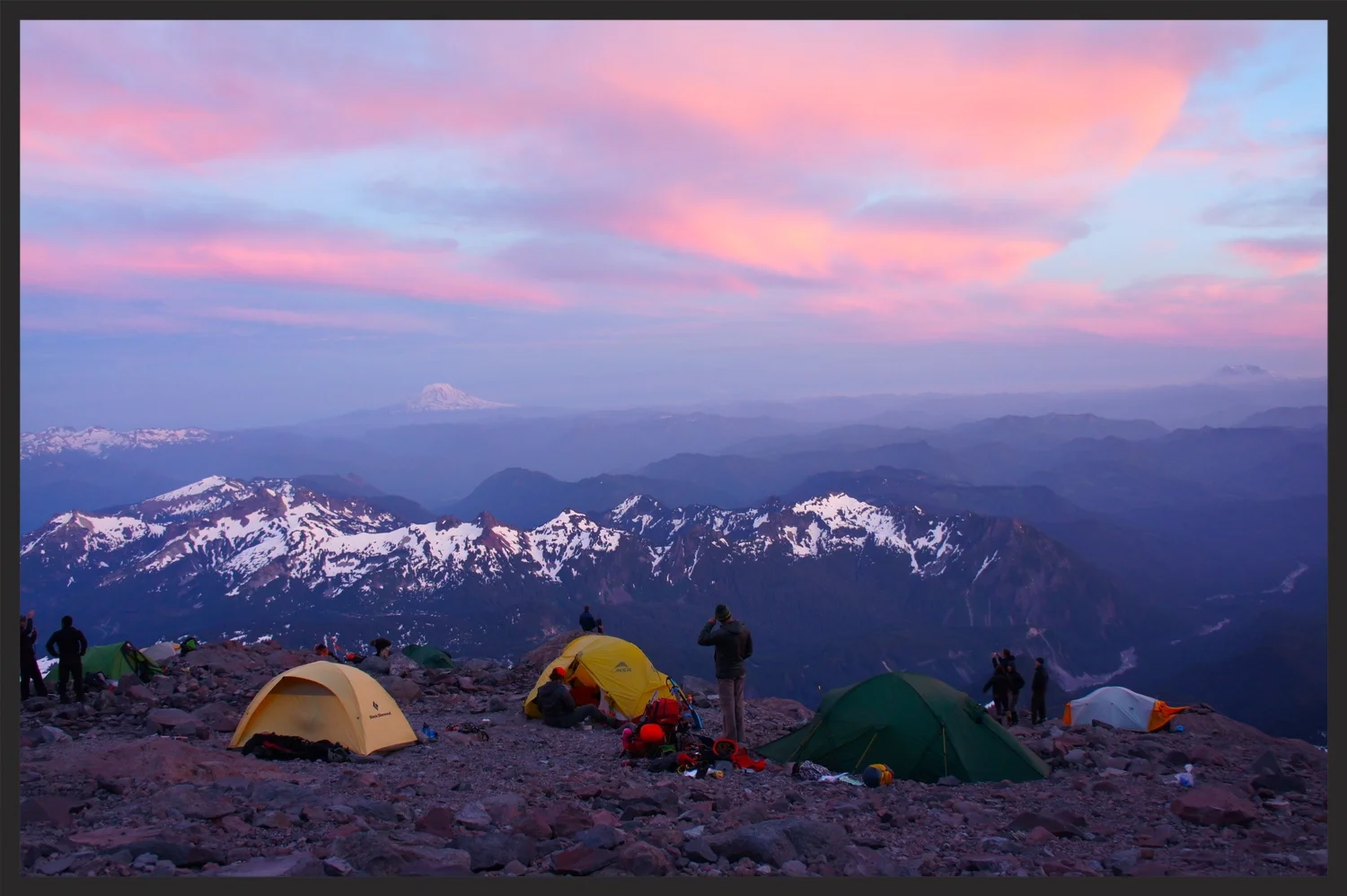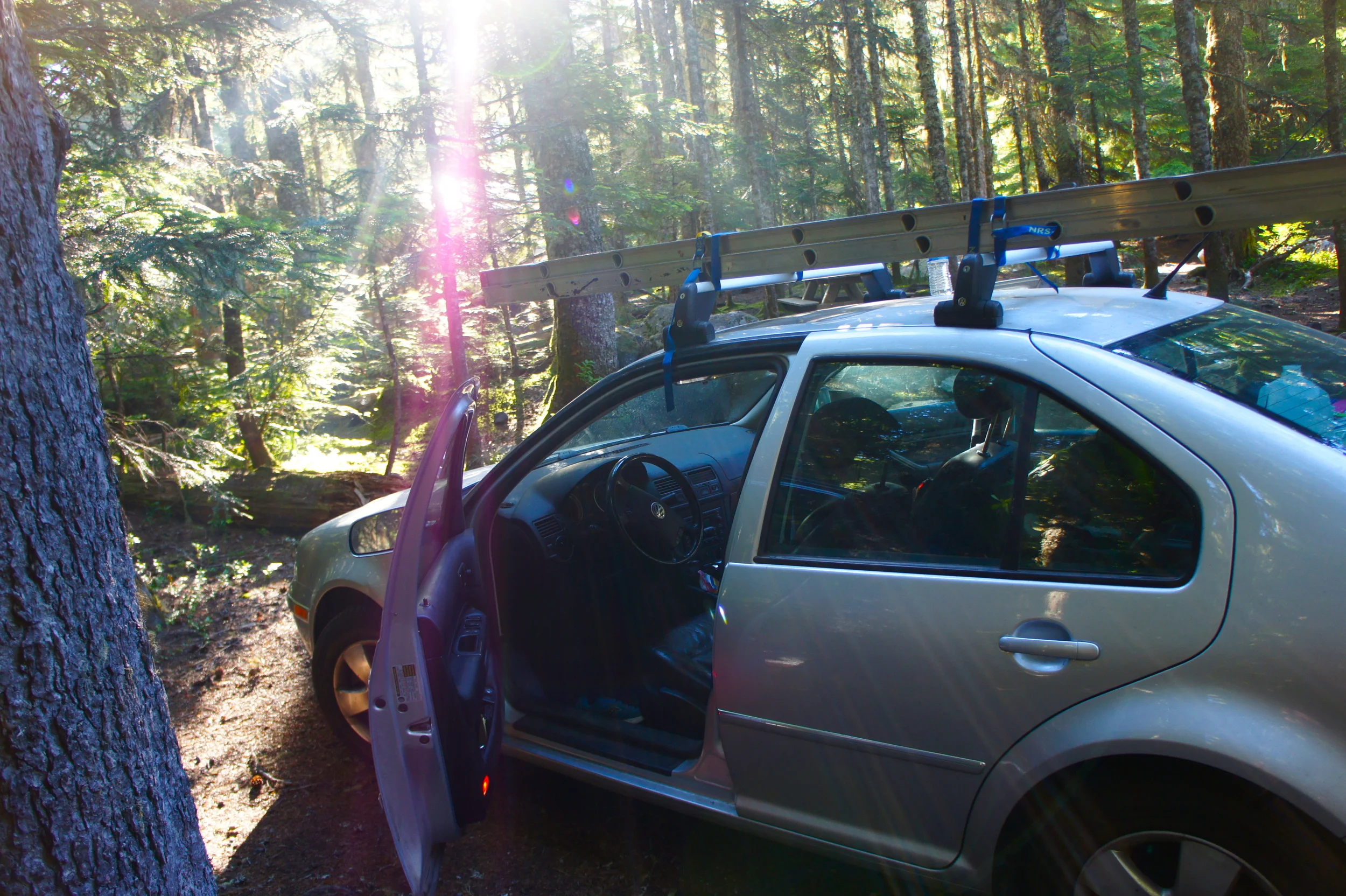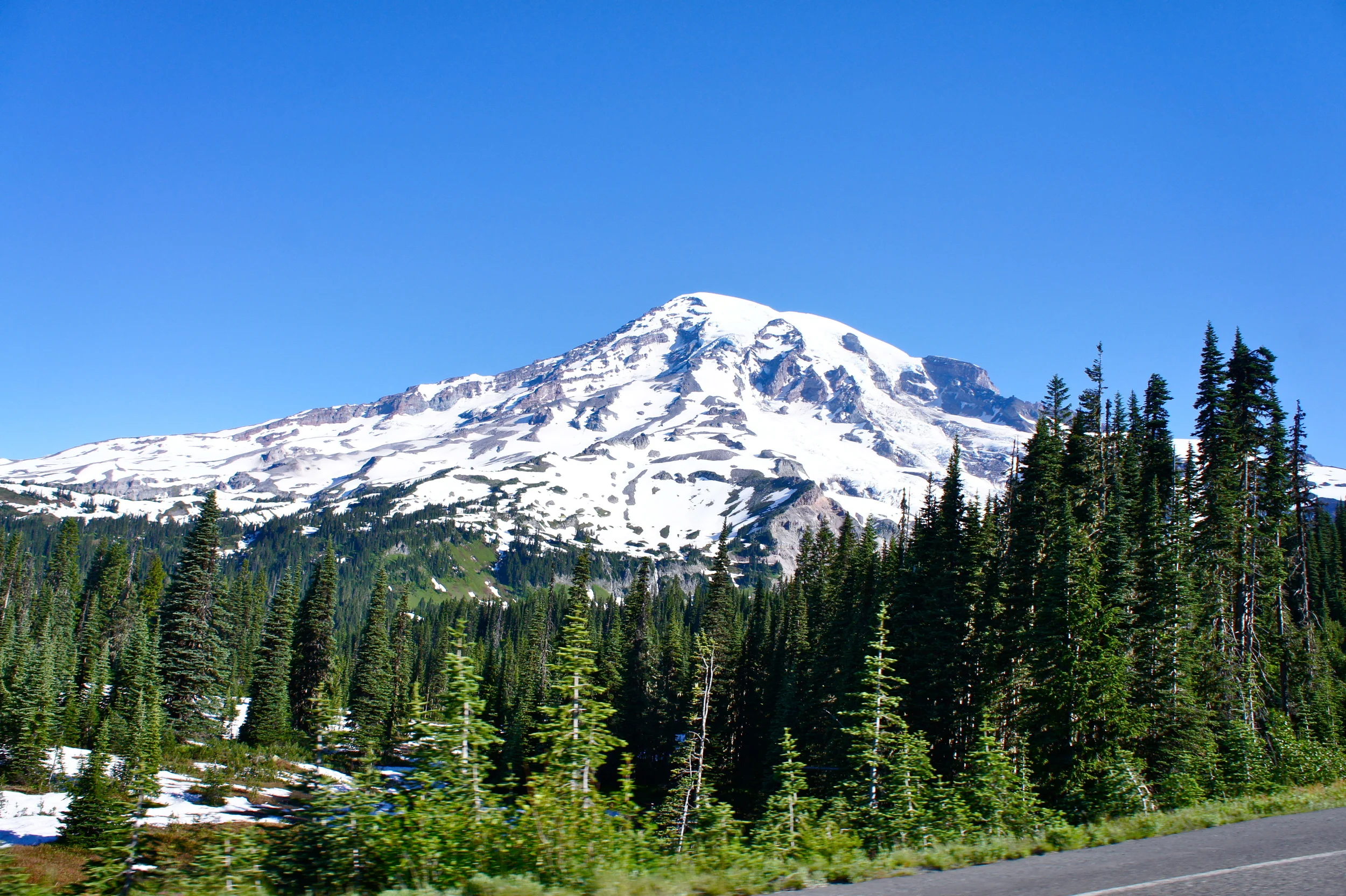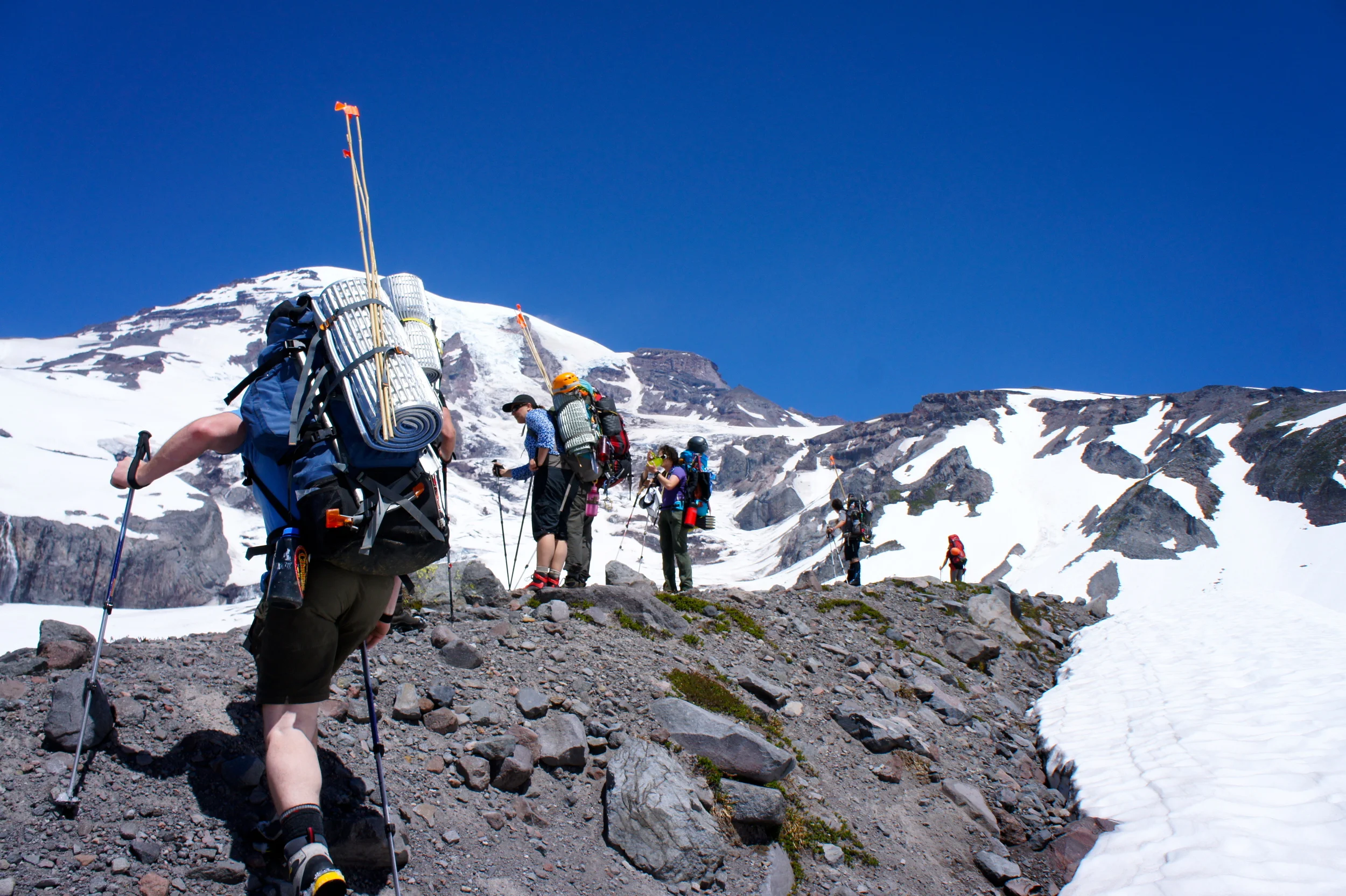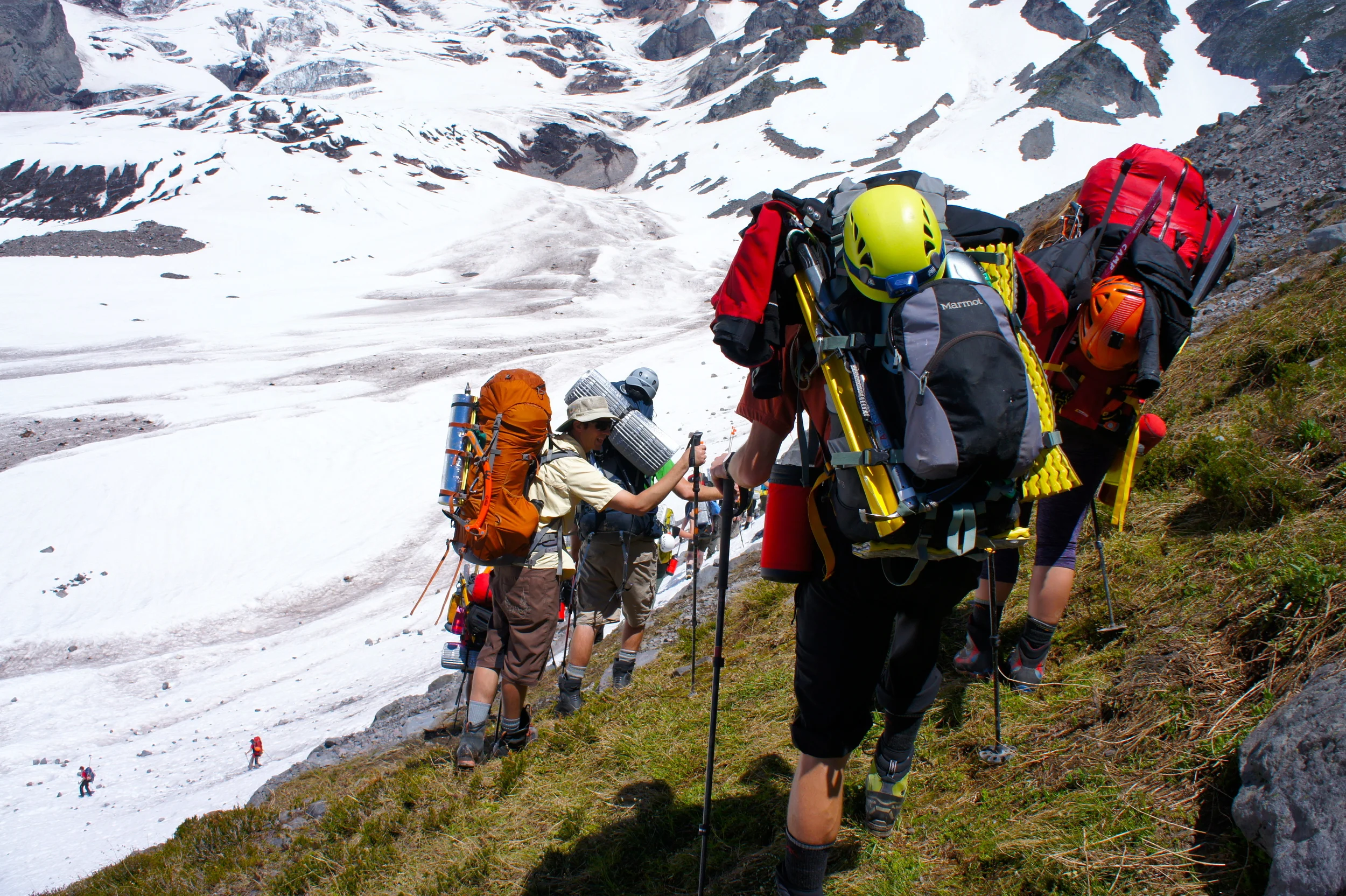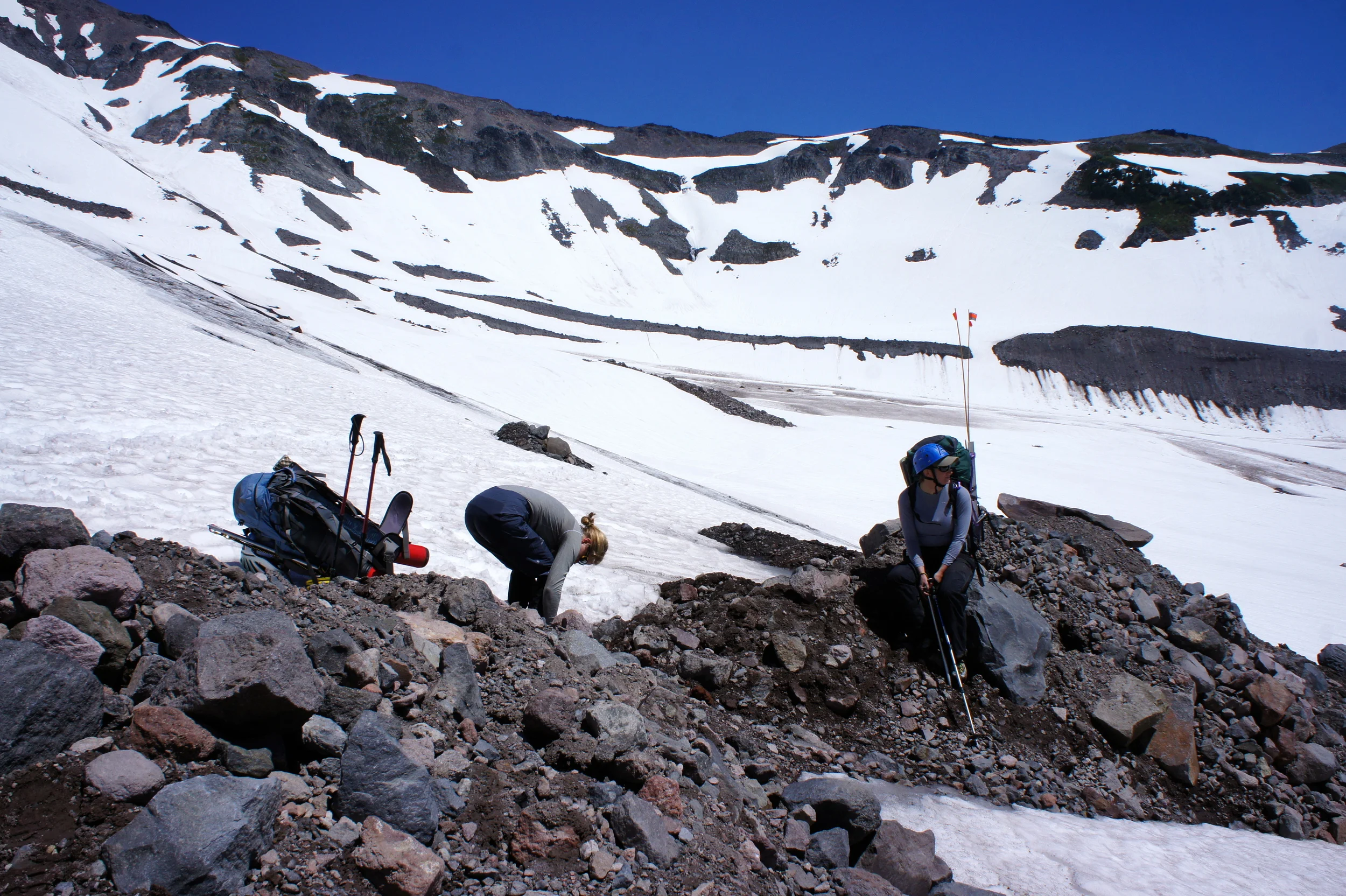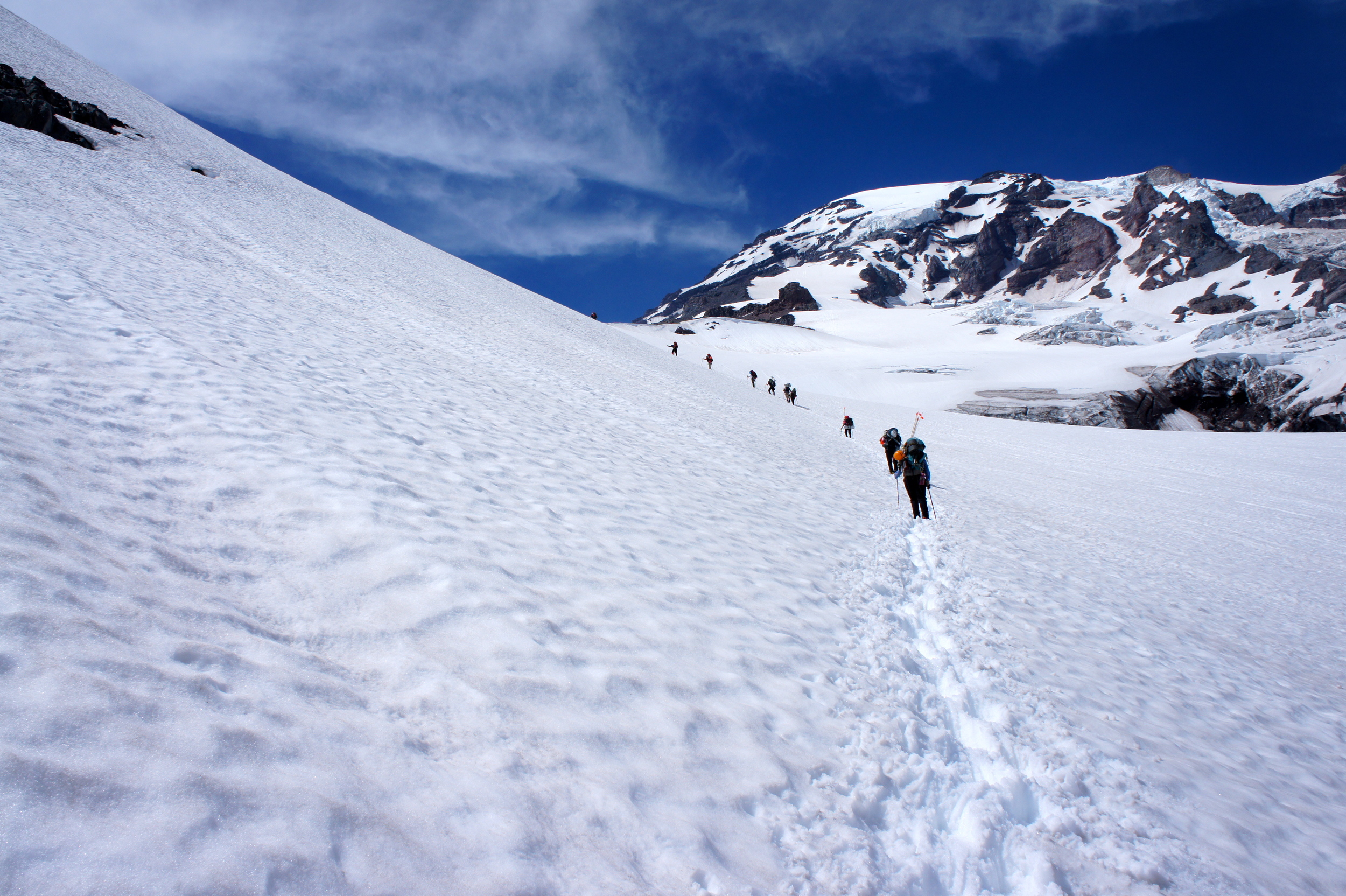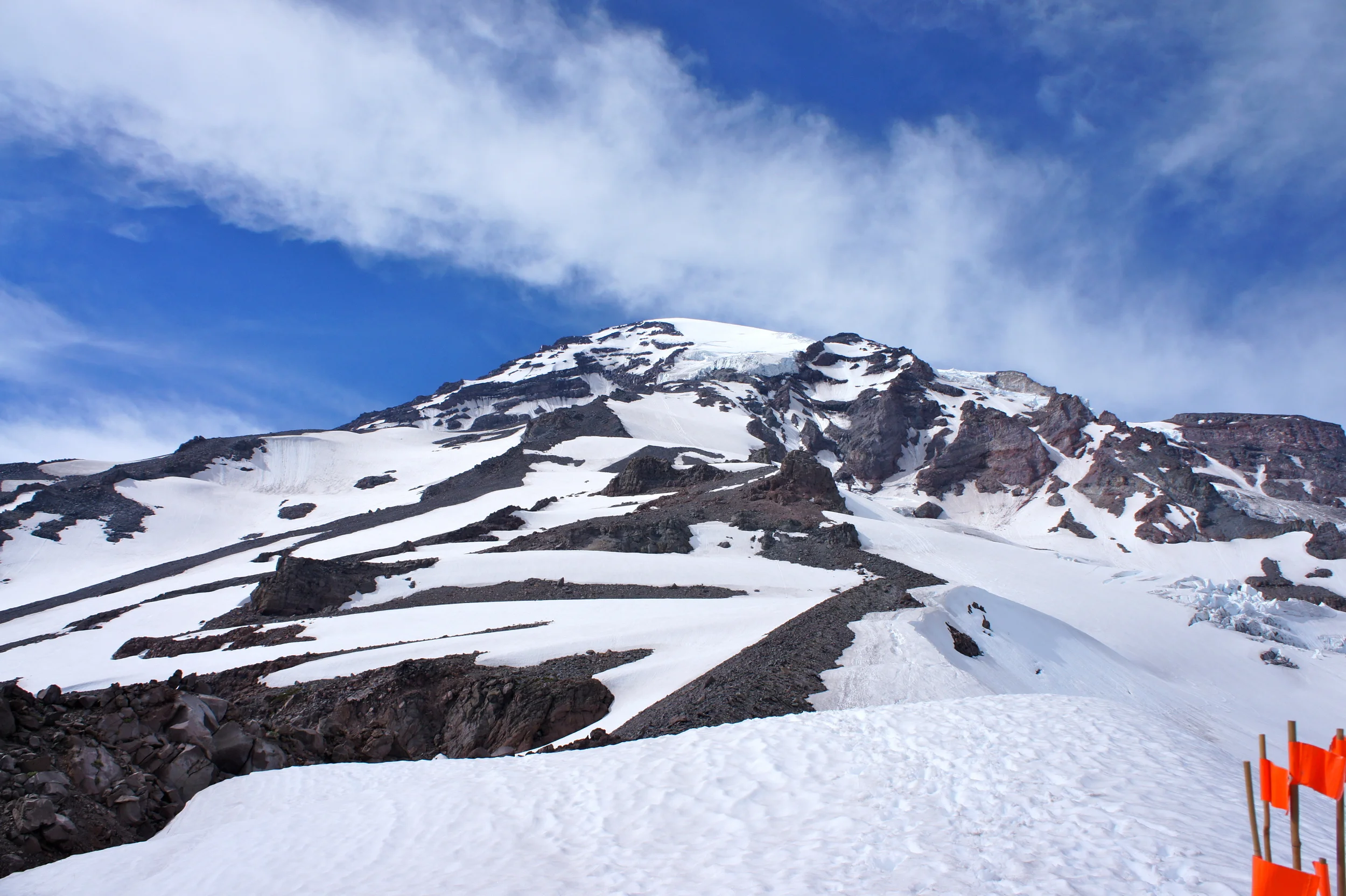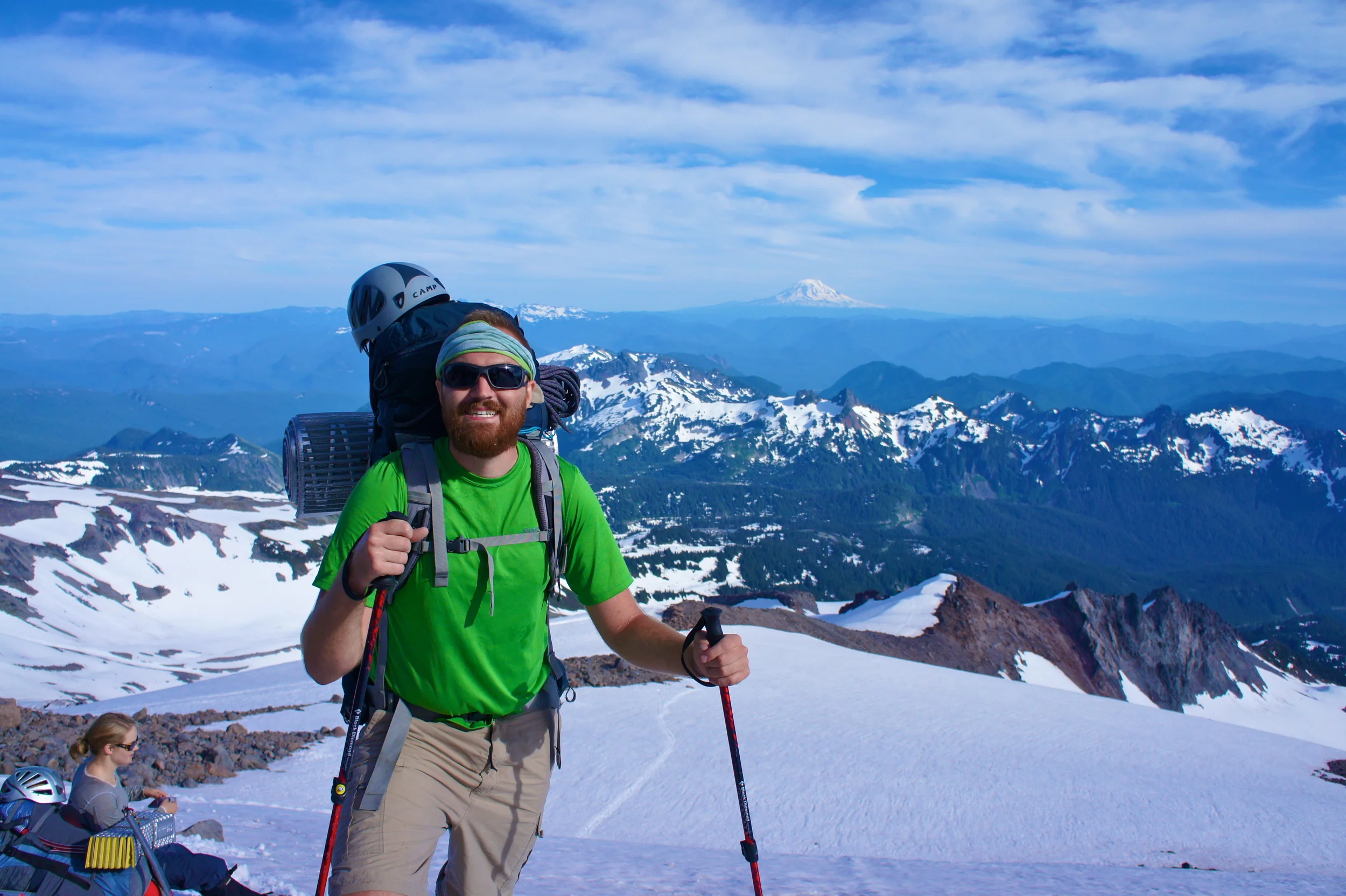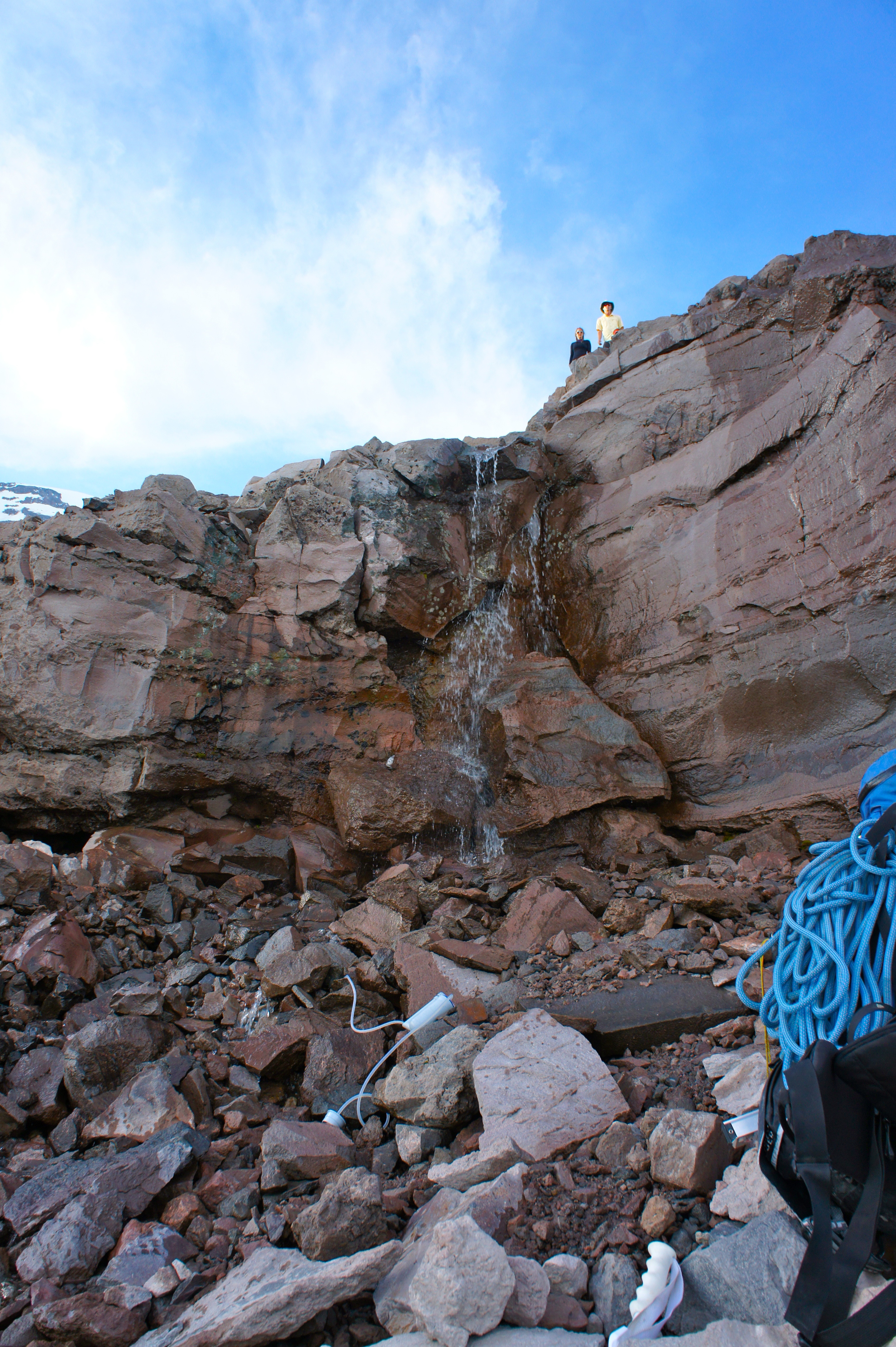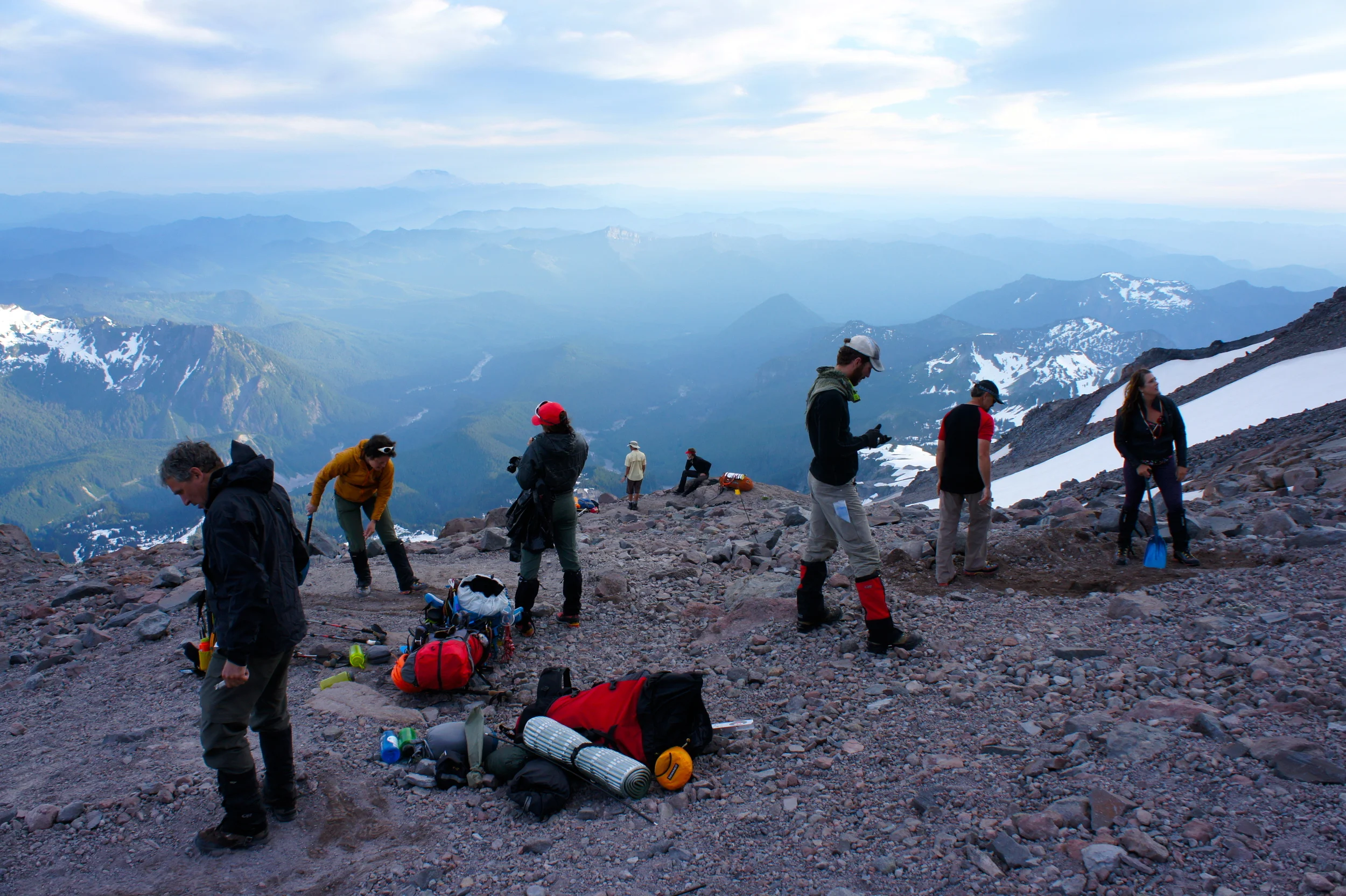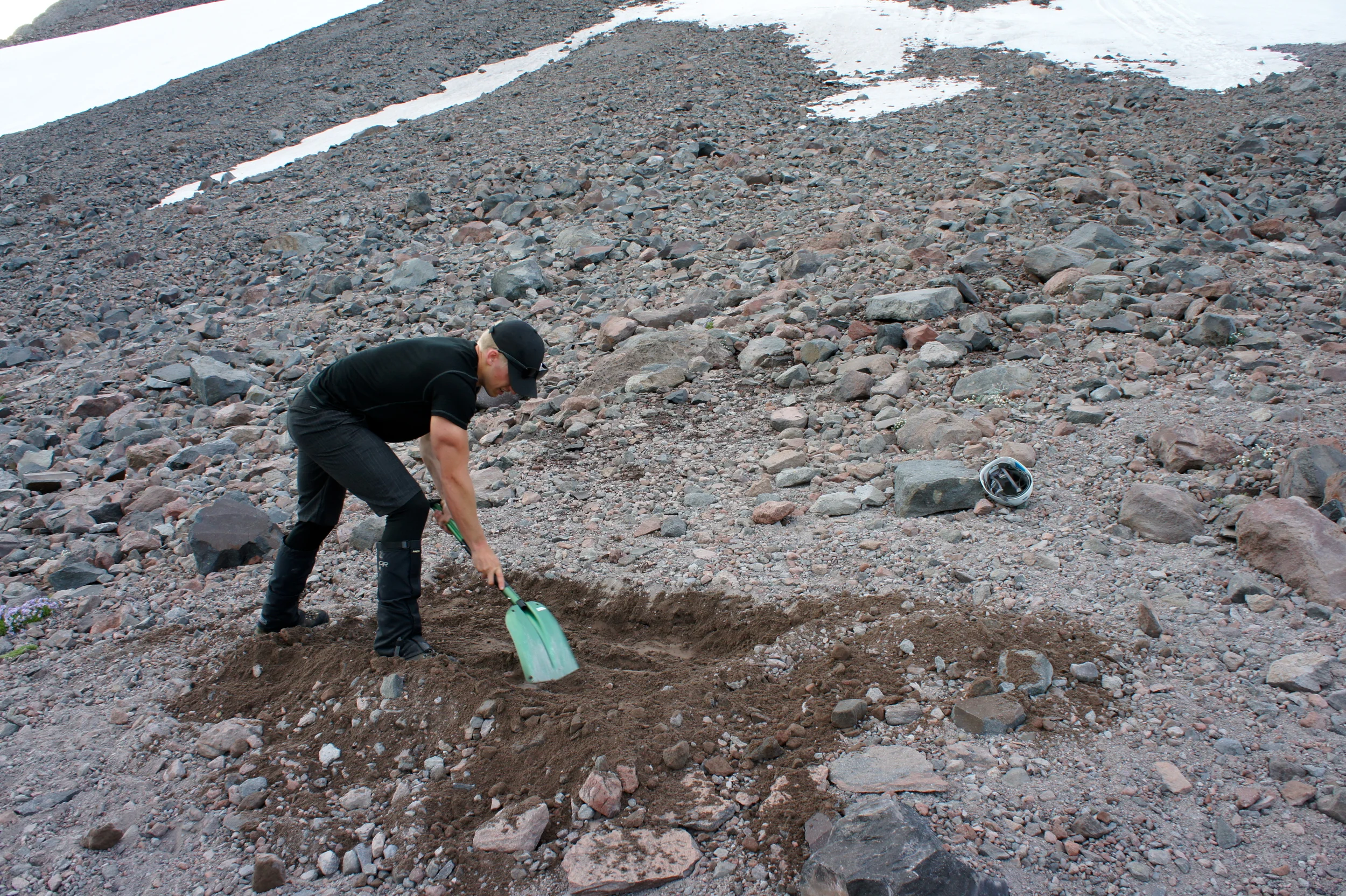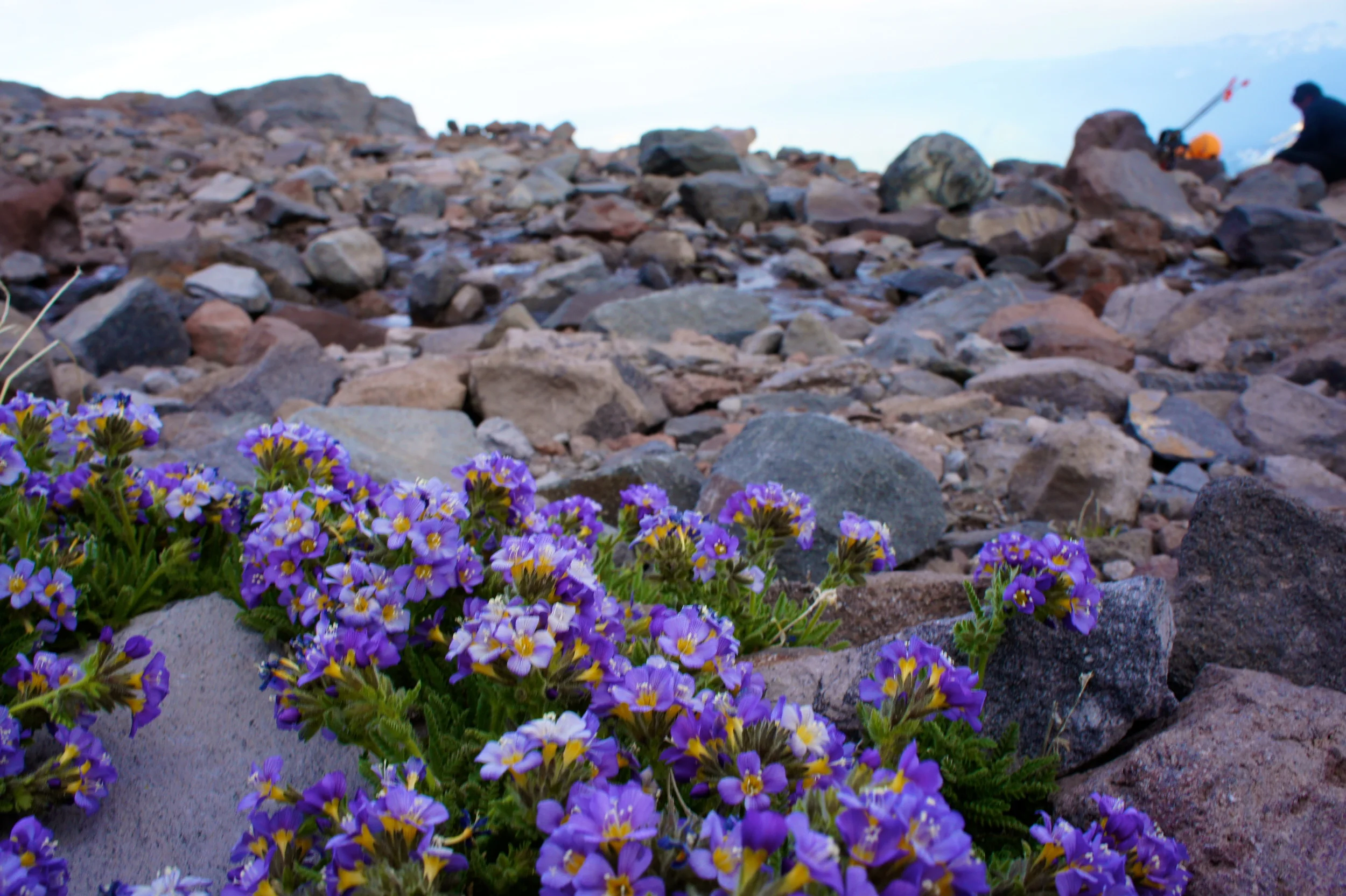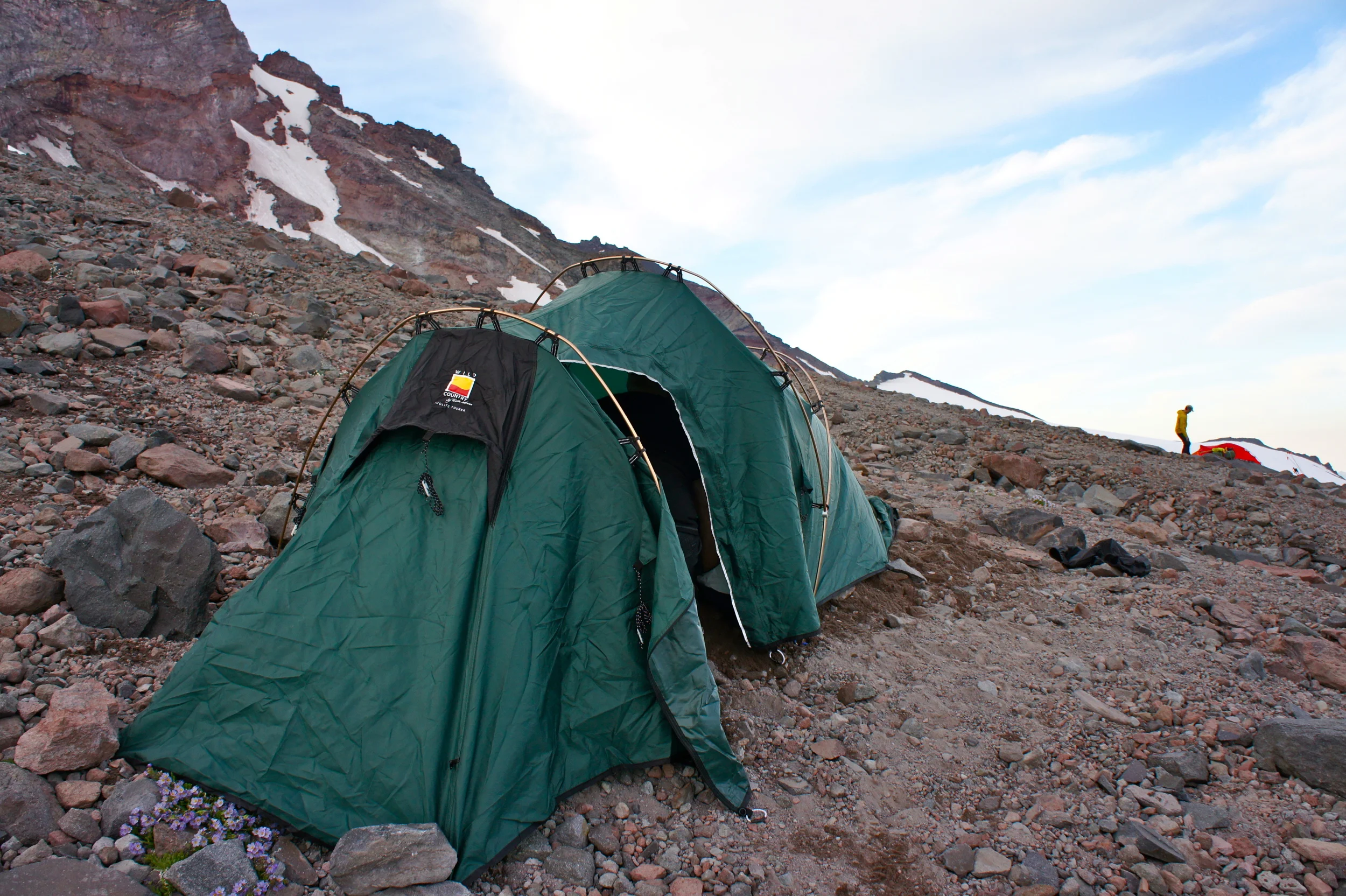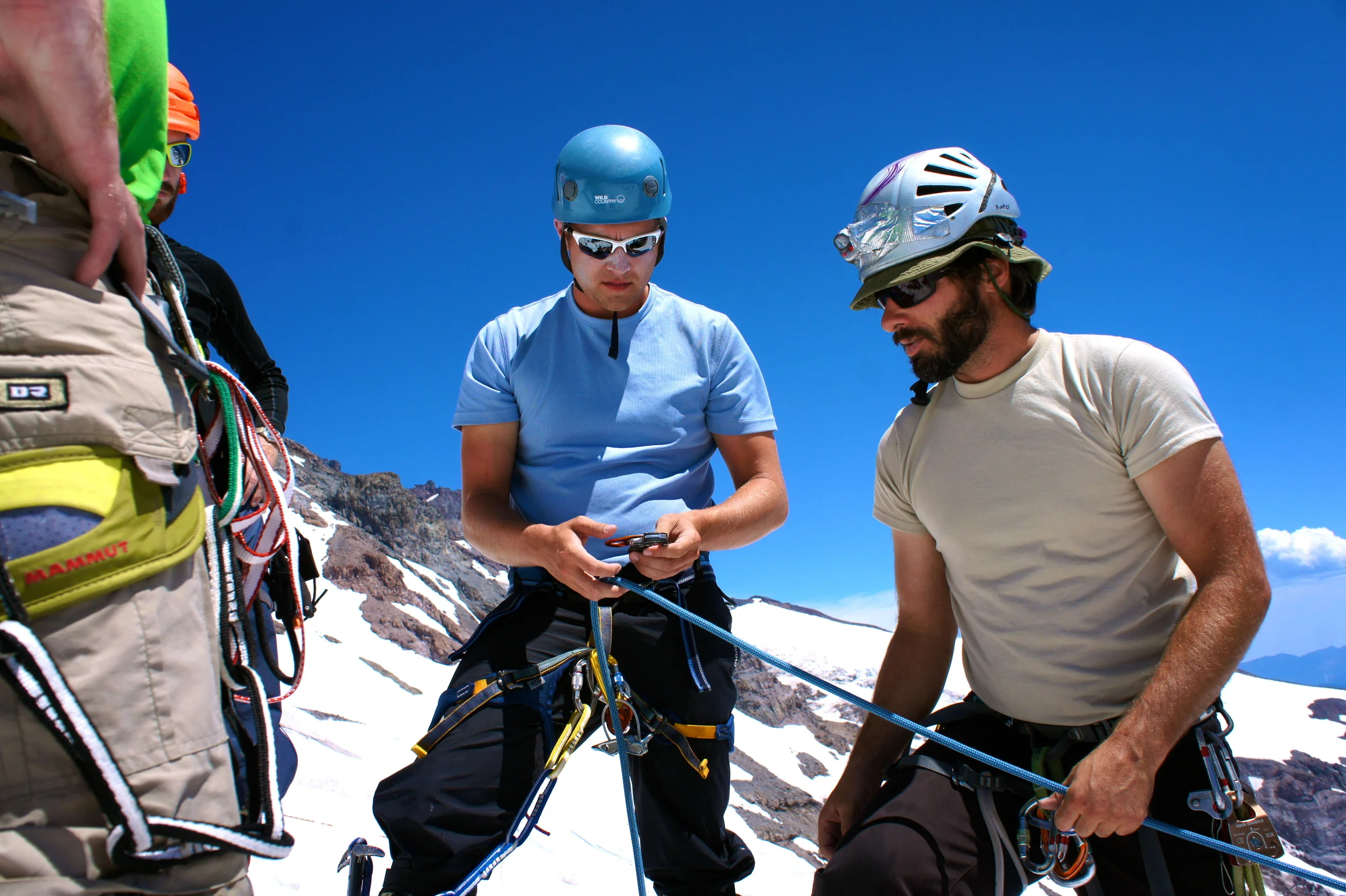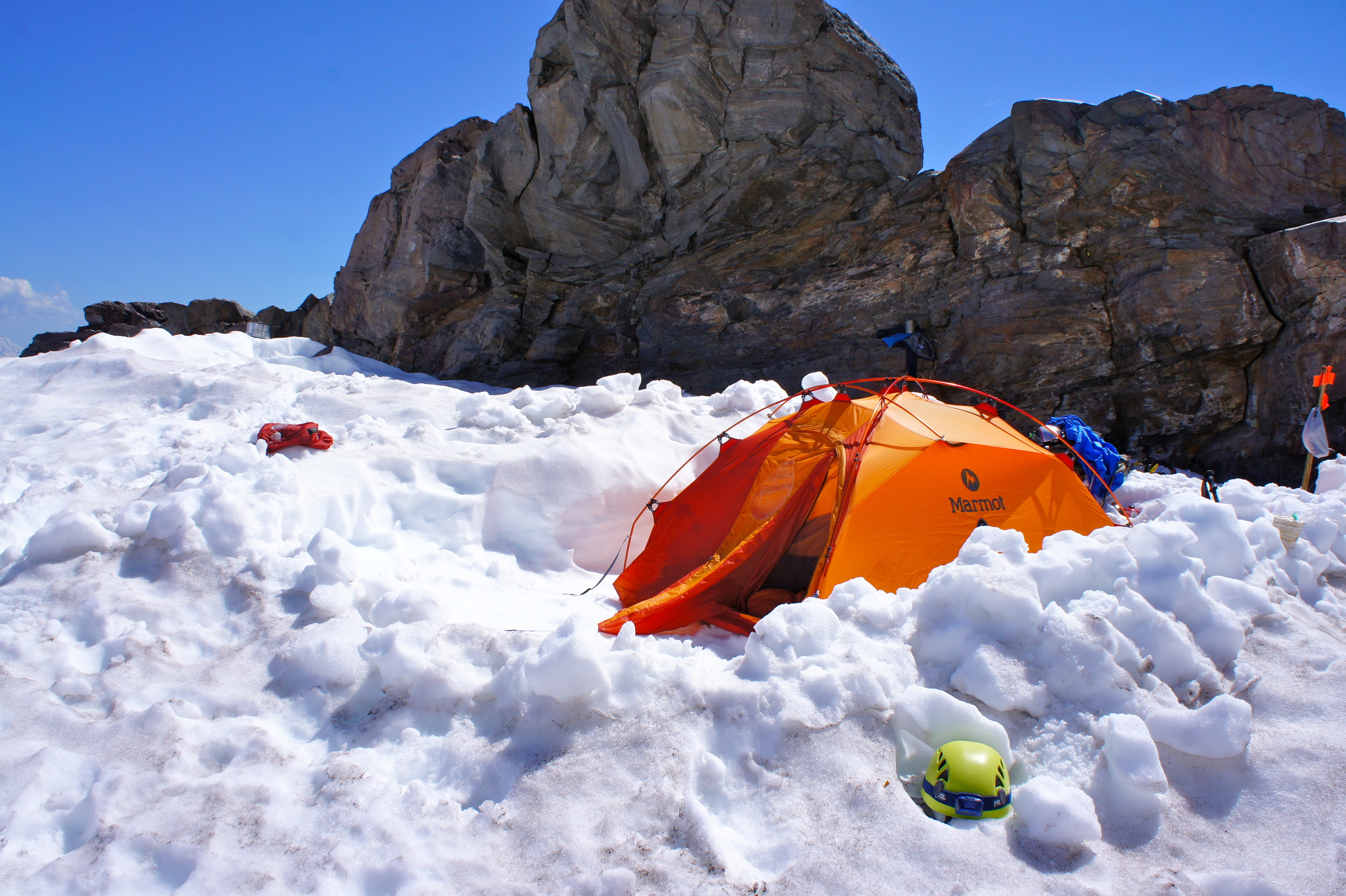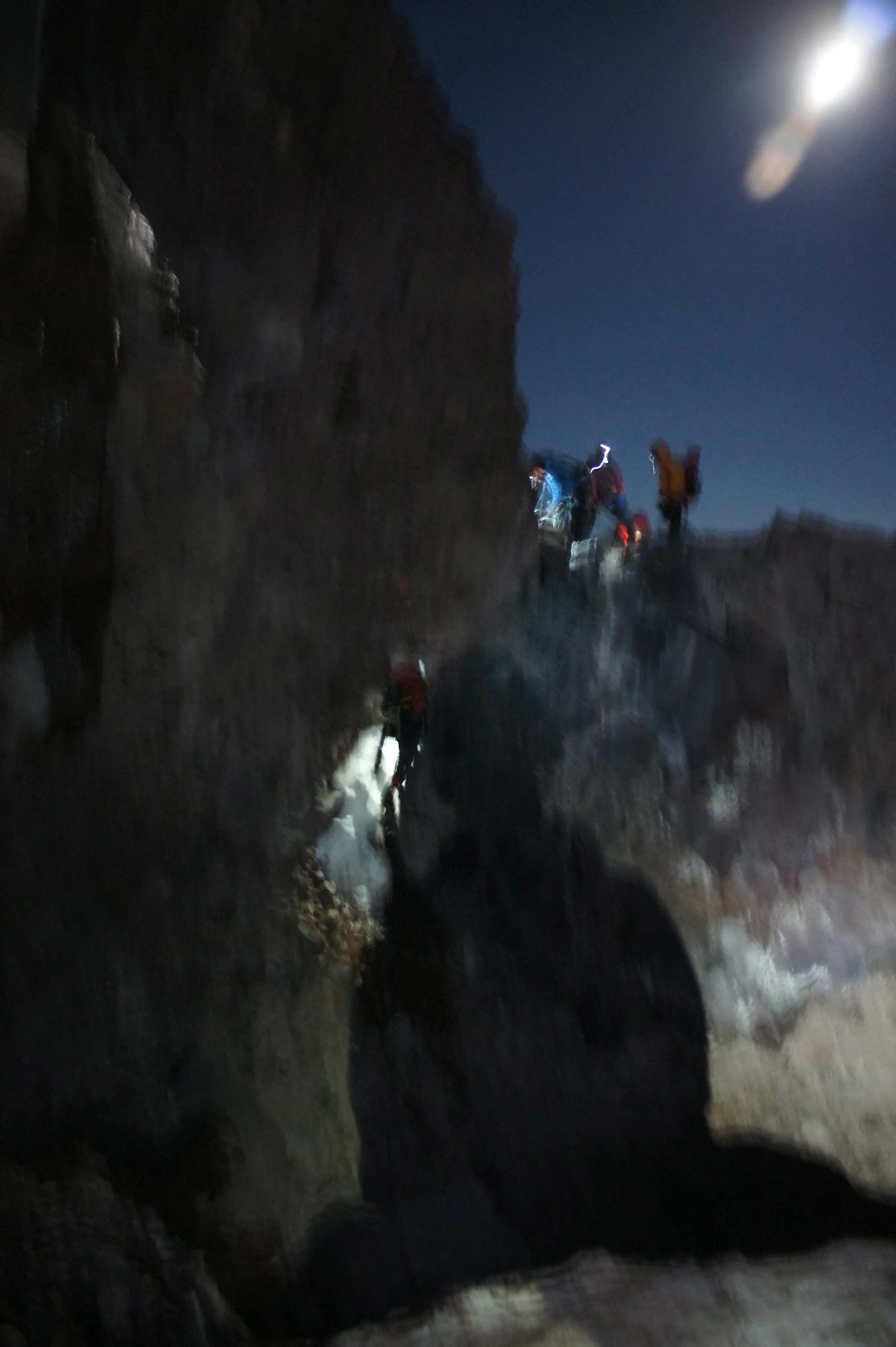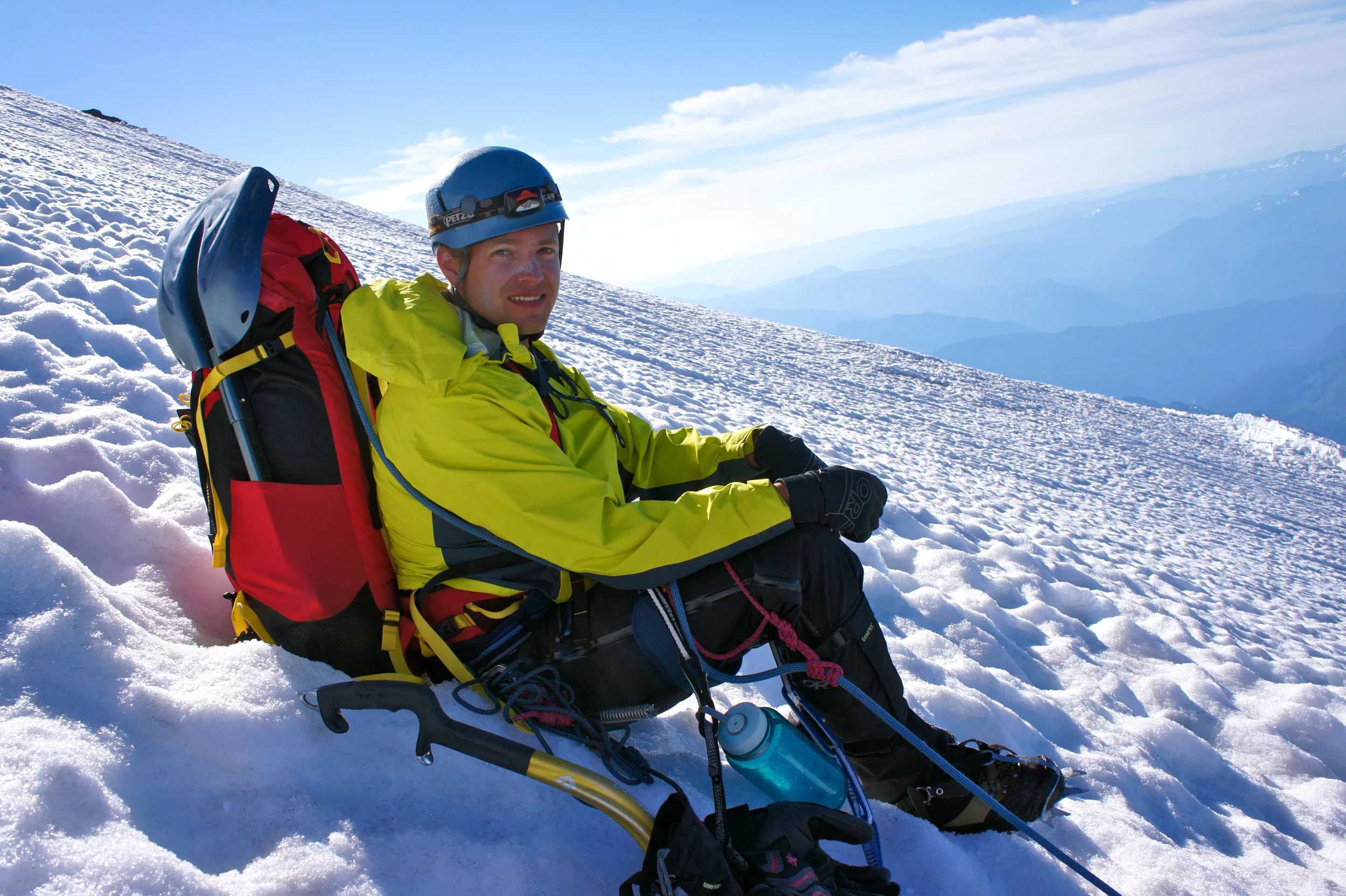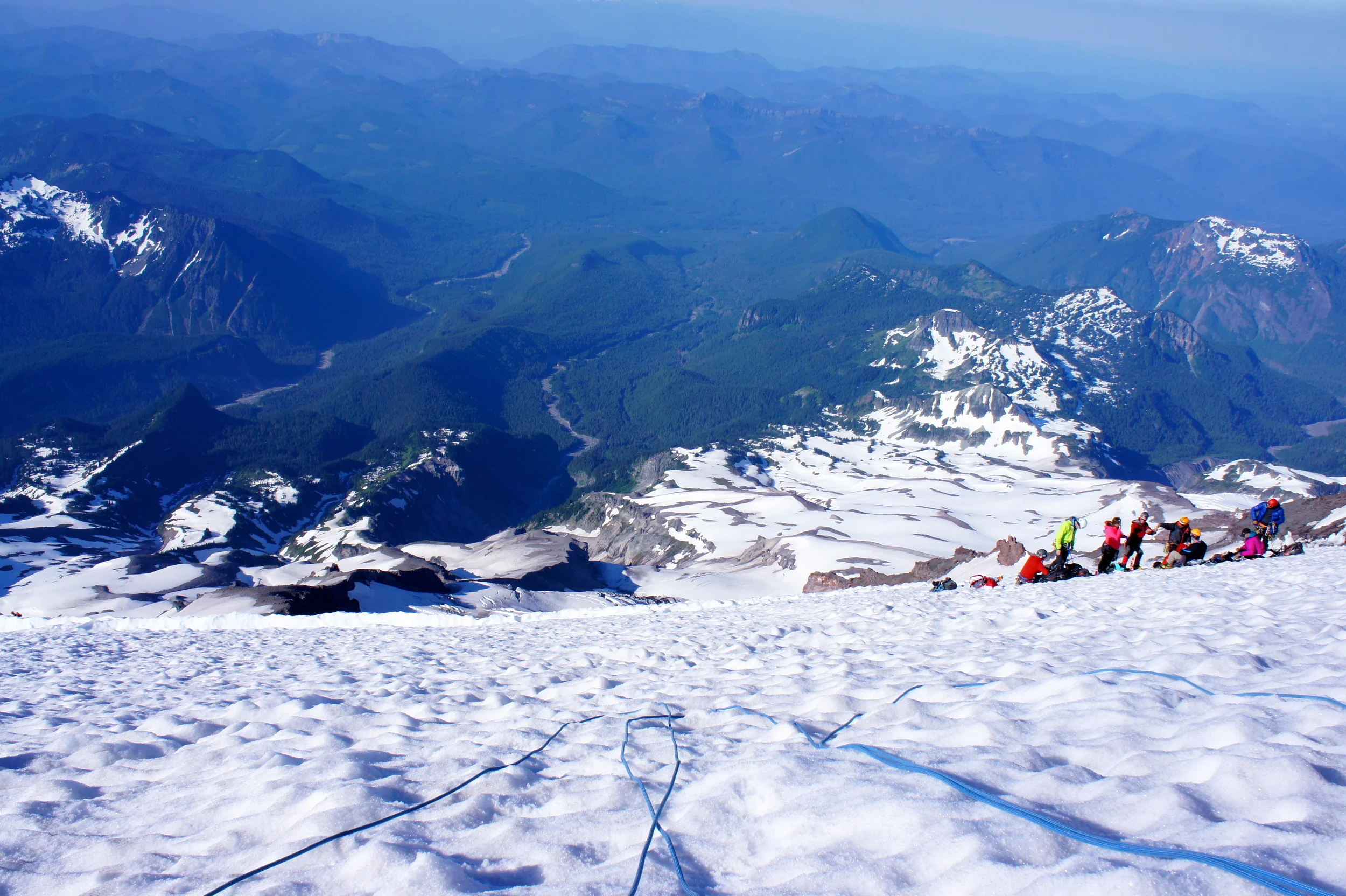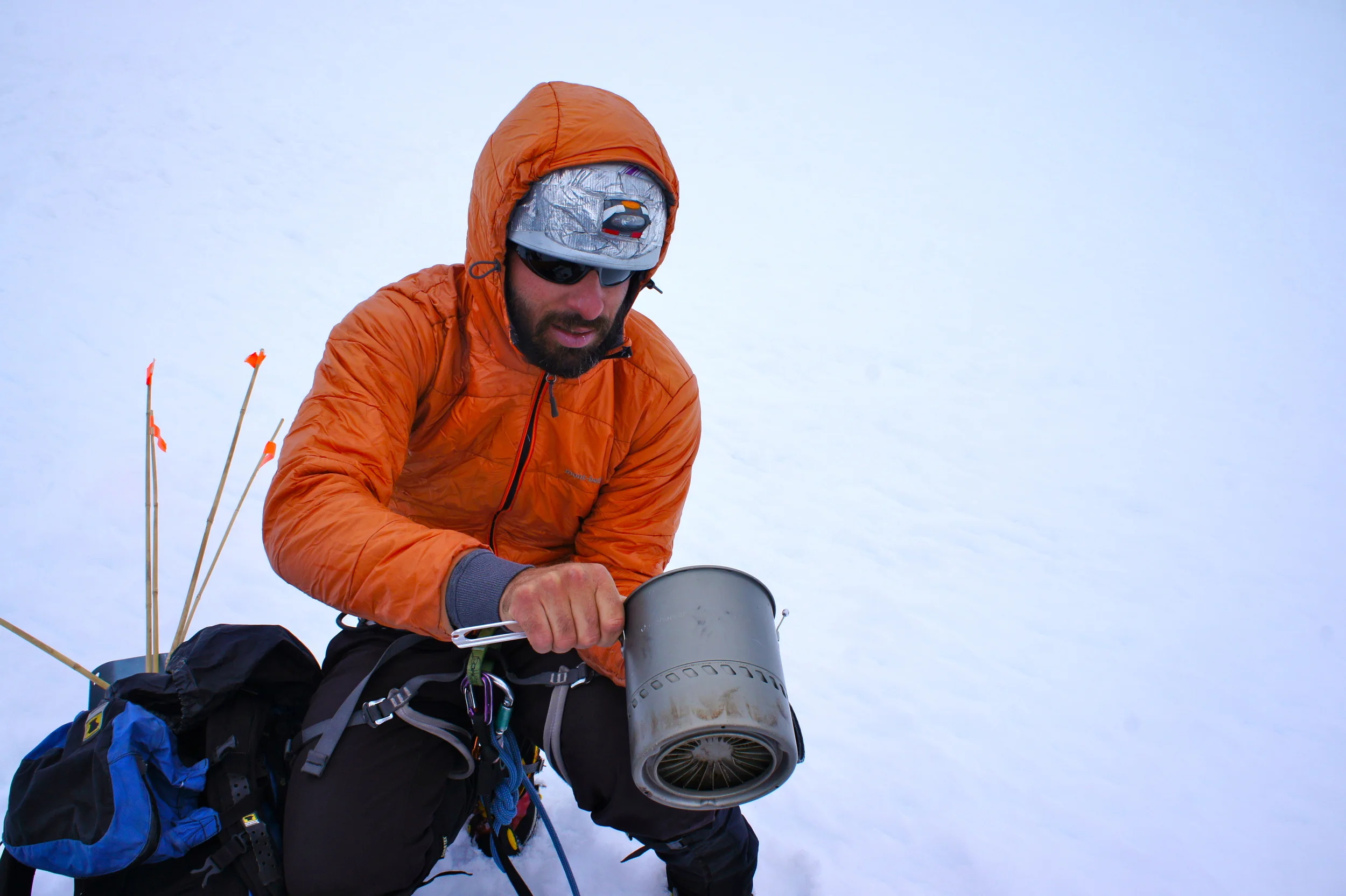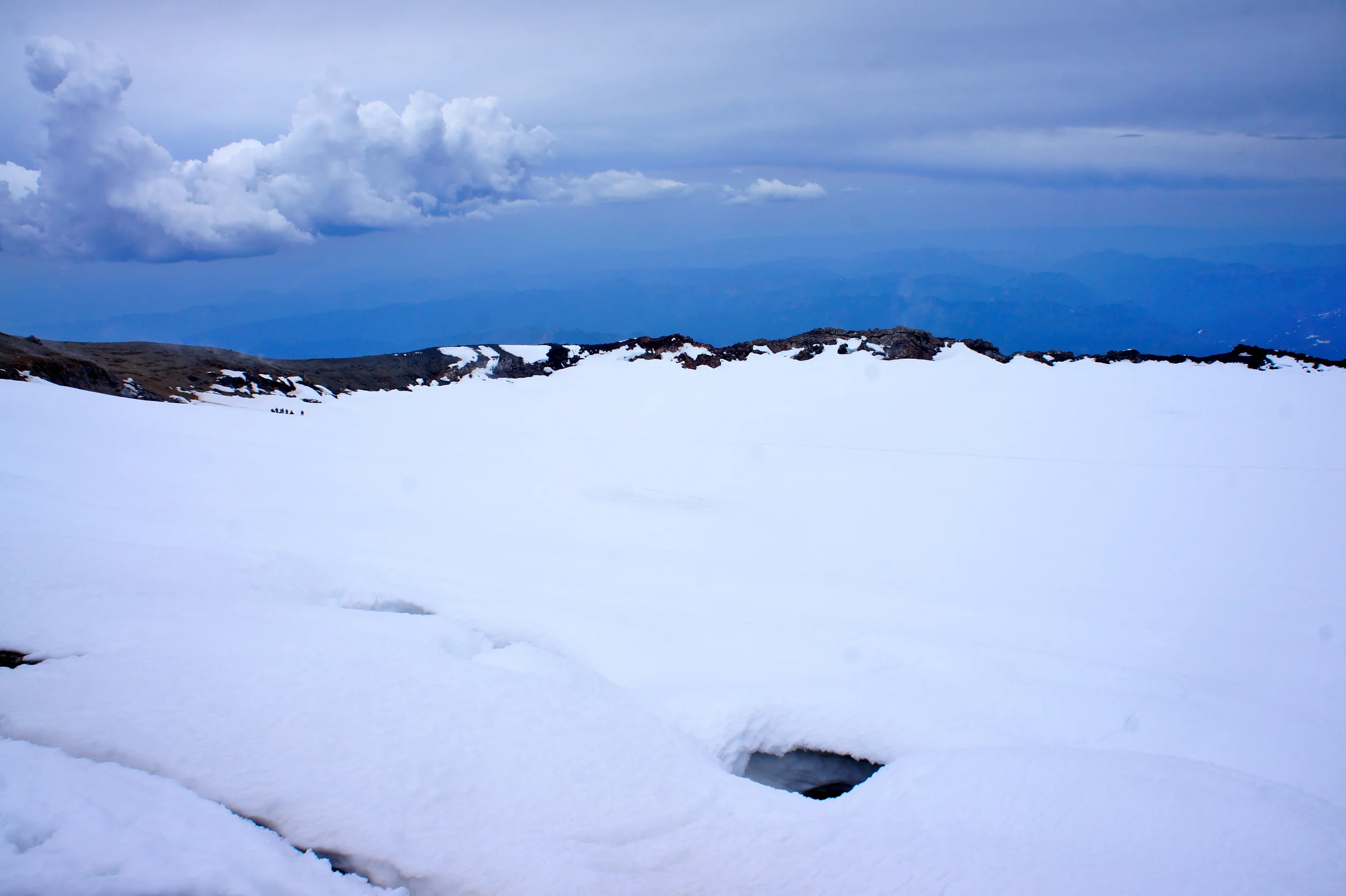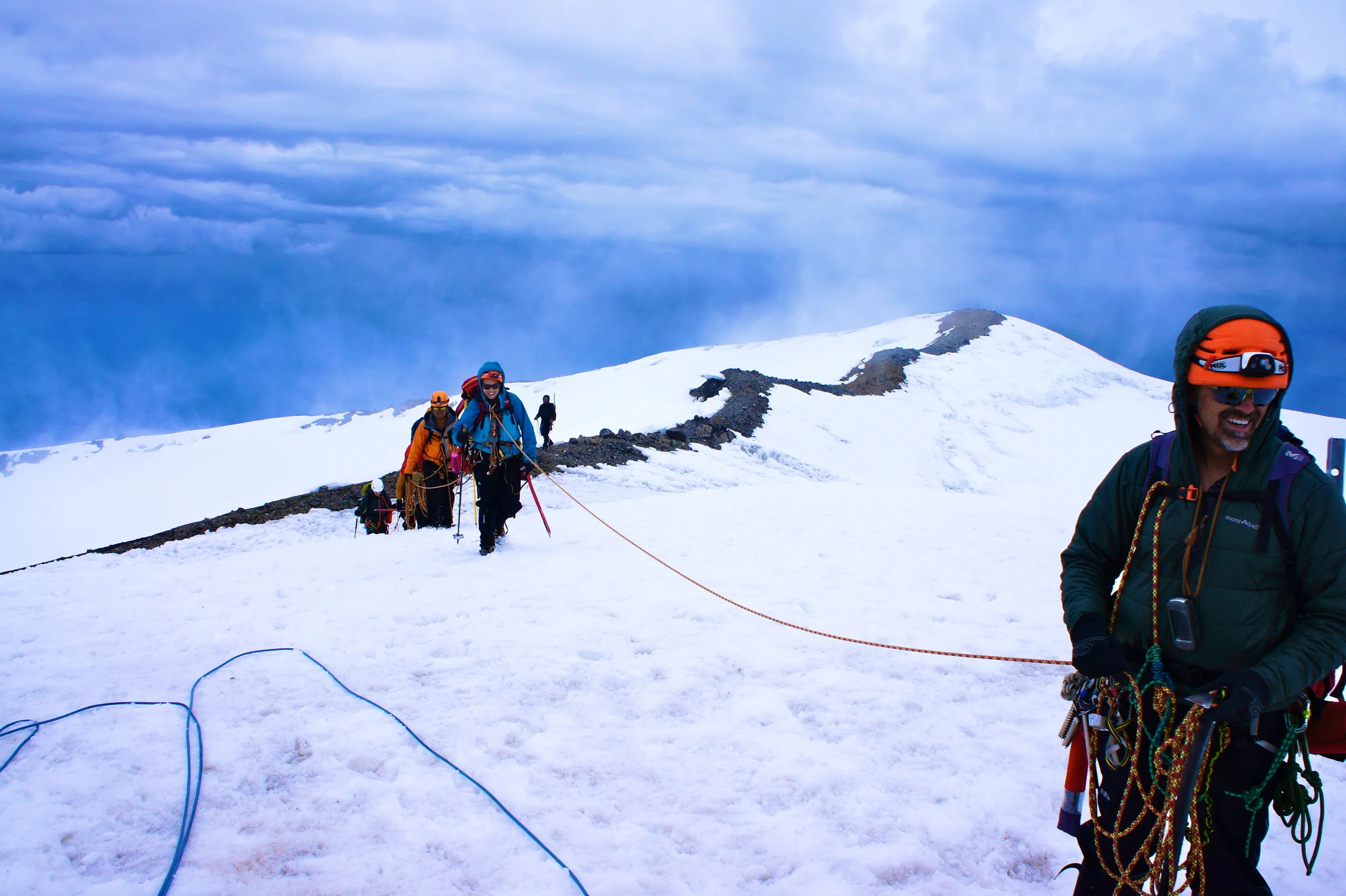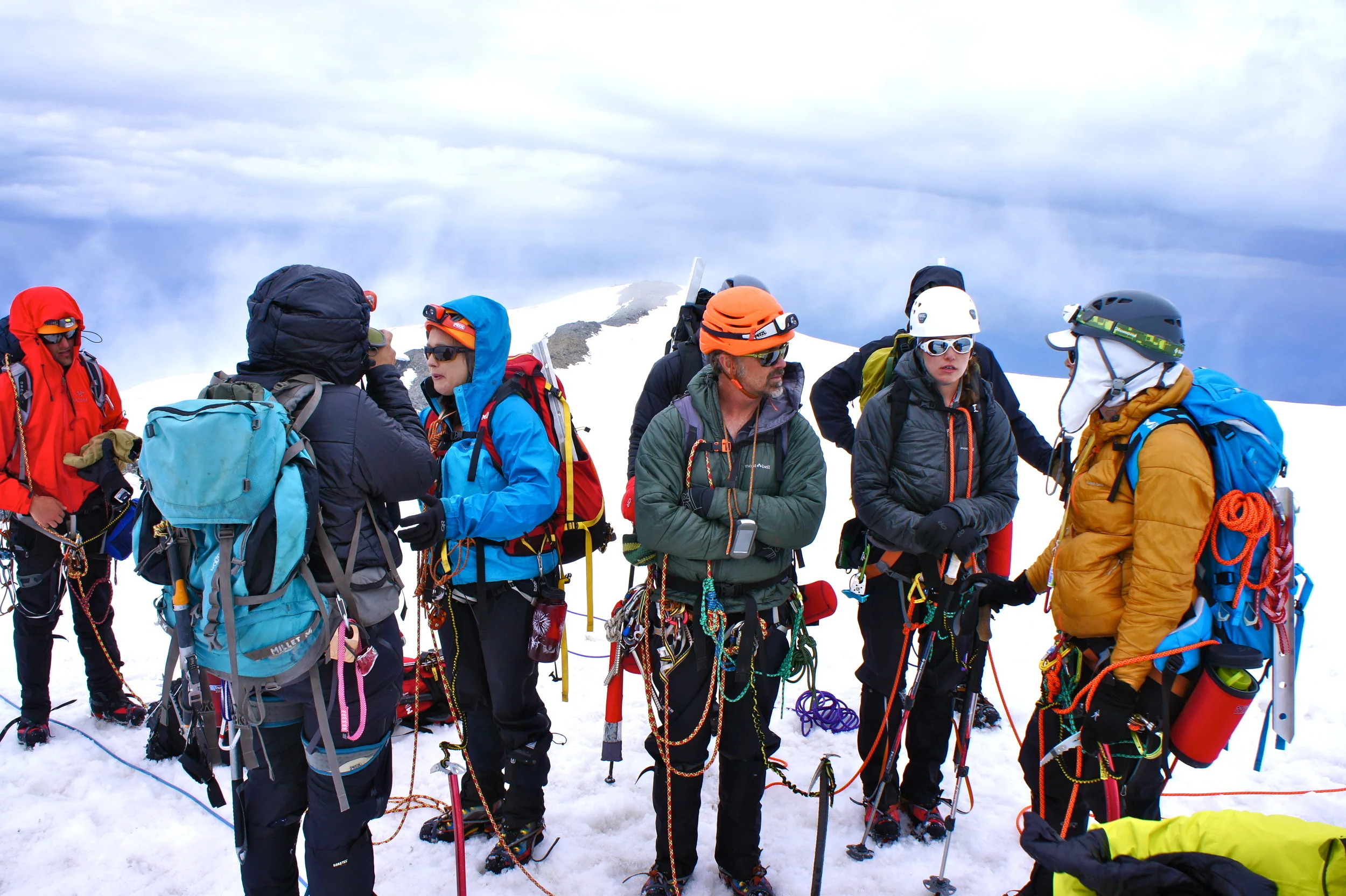The Great Mt. Rainier -- Via Kautz Glacier Route
Oh man. Where to begin.
Last weekend was the weekend the climbing club was going to climb Mt. Rainier in hopes of achieving its summit. Let me list a few facts about the mountain.
Mt. Rainier is a volcano southeast of Seattle, Washington. It is the highest mountain in the state of Washington and 4th tallest in the Lower 48. It is the most heavily glaciated peak in the lower 48 with 26 major glaciers, giving you the opportunity to experience the glacier travel that can be found on big mountains such as K2. It is unlike any mountain I've ever been on.
"Steep glacial ice and huge crevasses challenge routefinding and technical skills. The thin air of high altitude strain every climbers constitution. Storms from the Pacific bring heavy snowfall, whiteouts, and fierce winds." --Mike Gauthier
Over 10,000 people visit the park every year in hopes to summit, and the success rate is only about 50%. There are about 40 principal routes on the mountain that lead to the summit. The mountain has a rich history of successes and failures. The route our group took was called Kautz Glacier.
I've attempted to draw a picture of the route we took up the mountain. It's not my best work, but bear with me. The route was roughly what you see below.
From trailhead of Paradise to summit the route is about 9,000 ft. of elevation gain. It is a Grade II or III route with rock and icefall hazards along with glacier travel and 50 to60 degree snow and ice slopes.
I'll start from the beginning. The drive from Bakersfield to Mt. Rainier took about 16 hours. I rode up with Beth and Jake on Thursday, and we got into the park about midnight. The ride, although long, didn't feel too bad... We had a good time driving through northern California, making fun of Portlandians, watching climbing videos, asking siri ridiculous questions, looking at rivers and potential crags... We camped in the park that night - a fairy forestland.
Friday morning we drove up to Paradise to meet the other club members to begin the ascent.
I ordered a new backpack for the trip because my smaller 45 L backpack was not cutting it. This baby below fits 60+20 L and is lightweight and streamlined for mountaineering. It has designated spots for your mountaineers axe and ice tool. I had to pack in the parking lot, but got some help from the club members.
It's hard to see, but my pack weighed about 50 lbs, the same as it did for Mt. Whitney. I found out later I needlessly carried up a glacier rope that added to the pack weight, but oh well. My tent mate, Luke, carried up the tent and avalanche shovel, I carried up the stove and fuel.
We weren't able to get too early of a start in the morning because the ranger stations didn't open until 8am and it took about an hour or so to even get permits.
I think we ended up leaving about 10:30 am on Friday morning.
The goal for day one was to reach our "base camp" at around 9,500'. The trailhead is at 5400' meaning we had about 4100' of elevation gain to expect for Friday. Let the fun begin.
Carrying a heavy pack is about my least favorite thing in mountaineering. You've really got to learn to balance yourself and suck up the pain that is on your shoulders and back. It really matters how you pack your bag.
A week before this trip I strained my lower back pretty fierce running for an hour at lunch. It had been feeling better a couple days before Rainier but carrying that heavy pack really brought back all the pain, and at first I remember thinking that there was no way I was going to make it up to base camp.
Except the first hour or two of hiking with a heavy pack is always miserable. So I tried to remember that and eventualy I found a rhythm of taking enough breaks to walking and the back pain became more bearable and the hike became more consistent and "comfortable".
There was only a brief portion of the hike on Friday that was on a visible trail, and as soon as we had gained about 1000' of elevation we had to again descend a 1000' of elevation down a steep slope and into this flatter area of the Nisqually glacier.
Don't let the snow fool you, it was quite warm out there. I was rocking nike shorts and a tank top in order to not die of heat.
The Nisqually glacier had a few crevasses but they were very tiny, you could easily step over them and they didn't pose a threat, so we did not rope up on our first day to base camp.
Here is a picture of one of the tiny crevasses.
Some bigger crevasses to the right of us, but we weren't going that far onto the glacier and were veering left towards what is called "The Fan".
The fan was sort of like a couloir and just involved a steeper uphill hike, but nothing too challenging. It was just freaking hott out. There was one ice block fall when we were heading up the fan that rand down the right side, which could've been dangerous if someone had been there, but we all stayed left of that area.
It's exhausting going uphill like that for an extended period. We took a short break at the top of the fan. Me sporting a visor with a helmet on top... ultimate sexy.
Basically the day went on like this. Walking, resting, walking, resting...
With breathtaking views of all the glaciers surrounding us.
Nothing too technical Friday, just some uphill portions and baby crevasses.
The whole hike on Friday we could see the route we would be taking for the summit, and we were constantly pointing it out talking about it... wondering what it would be like... because so far, this didn't seem that bad.
The long flags you see there are used to mark a route (if the weather is bad or if the terrain is confusing) and/or mark something dangerous like a crevasse or ice.
We had one really steep hill we had to go up using our crampons and mountaineering axes before we got to a final stretch of rock path to our base camp.
And fortunately for us, there was running water at our base camp! No snow melting for us! Instead we could just fill up our nalgenes and either filter or steripen our water. It took us roughly 8 hours to reach base camp on that Friday.
There were a lot of spots to set up tents and we all spread out looking for that perfect tent pad area.
Luke and I settled on this area, at the top of the camp, and we (or more just Luke) began shoveling out an area for our tent. to make our tent pad more flat instead of angled.
It's pretty amazing when you are that high up to see plant life and wild life. There were lots of little bugs and spiders and the gorgeous purple flowers everywhere.
We put some rocks on the inside of the tent to make sure it wouldn't go anywhere if a storm were to come.
Not a horrible little setup if you ask me. The only funny thing is that by the end of the trip a small little stream diverted and went straight through our tent pad. It wasn't bad, but the ground just got pretty damp the last day we were there.... so OK, maybe we weren't tent pad picking experts, but I'm getting better. Whitney's spot was even worse and more uneven.
With the weather that we had, I could've stayed up here forever. It was one of the most gorgeous areas I've ever had a privilege of spending time in.
There was literally nothing but mountains and forest surrounding us. If there hadn't been so many club members at base camp I would have felt extremely secluded here.
And then the sunset that night.... my god.
If Rainier had only given me one gift, it would have been this night.
The night before we decided that instead of summiting on Saturday we would take a rest day. There had been talk at the ranger station that there might be bad weather at the summit on Saturday, and the clouds the next morning also suggested the same thing.
So instead, we all slept in, enjoyed the views, anddddd practiced crevasse rescue training in a real crevasse!
This was totally cool. We found an area to the right of our camp and built dead man anchors with our pickets (shown below).
Then we practiced building a z-pulley and pulling someone out of a crevasses.
As well as "self rescue" by prussiking our way out of the crevasse. The picture below is me down in the crevasse.
The next two pictures are of the z-pulley set up using a microtraction and pulley system.
Everyone got to go into the crevasse twice. Once to be pulled out by the z pulley system, another time to self rescue themselves.
I really liked this photo below. I think it shows how big the crevasse was that we trained in really well. I didn't take this photo, this photo is by club member Ryan Loveless.
It was really excellent training. The only other training I had was in Jake and Beth's front yard pulling a chair across the lawn. This was definitely a more true-to-life training experience.
There was one team member who set up his tent in the snow area instead of the rock section. I just thought his tent set up looked pretty sweet.
After training, we all ate something, and by around 5 pm we finished packing up for summit day (with only the essentials so that our packs would be lighter), and went to bed about 6pm. We would be waking up at midnight to start for the summit day push.
You'll notice I don't have quite so many pictures of summit day push as I do of the approach to base camp... partially because the morning portion was in the dark, and also because I was too preoccupied with my fear and being technically challenged and exhausted.... which I will go into later.
The summit push began at 1am. We left camp and hiked up a big snow field known as "The Turtle", and that lead to this area below where we had to down climb some rocks to an area leading below what is known as the Kautz icefalls. The down climb wasn't super complicated, and there was a fixed rope here to hold onto as you down climbed. My picture sucks because I don't understand how to take pictures in the dark I guess.
Next we had to rope up with our teams of four. My team was Jake, Beth, and Arick. From this point on we would be roped up the rest of the trip. We were headed to the base of where you see all the headlamp lights in the picture below. The base of two pitches of 50 to 60 degree glacial ice climbing that we would end up "simul-climbing" in our rope teams. The first two pitches of ice climbing weren't all that technically challenging. I've done only a couple of ice climbs in my life, but found i could keep up with this one. The scarier part here was maintaining a good pace in the simul climb with the other team members of mine. Jake lead the pitches and it was slow going, but we all made it without any significant event.
At the top of the first two pitches you have to walk a mildly crevassed snowfield to get to the third pitch of ice climbing. Which is a bit steeper than the first two. There was a lot of traffic on this ice climb with even other groups that weren't part of our teams.
Photo below by Ryan Loveless.
There were two main routes the rope teams were taking. One up some more aggressively vertical ice without places to rest, and the other interweaving the blocks of ice. Jake chose to lead a route up the blocks of ice which provided rest stops for us was we climbed up the route.
Photo below by Ryan Loveless.
It was a slow, long morning up the ice, but it was incredible I've never done anything like this on a mountaineering route. Although I was scared half the time, it was truly a unique experience.
Photo below by Angela Isaacs.
There's no rest for the weary on summit day push. We didn't take many breaks at all. At the top of the ice we entered the heavily crevassed Kautz glacier. Where all around you could see giant gaping holes in the snow. However, the scarier crevasses were the ones that you couldn't see... the ones covered by what is called a "snow bridge". With Jake as our lead, we began navigating the glacier and crossing crevasses where it seemed the safest.
The only pictures I mangaed to take were the few rest stops we took on the glacier. It's really hard for these pictures to capture the steepness of the glacier and the grandness of the crevasses, but you can see on of the big ones below... with climbers ascending above it on steep snow terrain.
This portion of the climb was scary and long and exhausting. It was mentally and physically draining. A lot of focus had to be spent in making sure your steps were confident and that you maintained a pace with the group. It's all kind of a blur now, and doesn't seem as hard when I look at the pictures, but I was really quite terrified this entire portion of the climb. I knew that messing up was not an option, and there was no turning around. The climb was committing and unrelenting. I was quite honestly out of my league.
Large gaps of time with no pictures, and we finally made it to "Point Success", only a small distance from the summit. This area was the first area we had been at in a really long time that was flat enough to feel safe to stop and take a quick food and drink break. Jake melted some snow at the top real quickly.
On the way up our team had considered possibly taking Dissapointment Cleaver Route (which is a more beginner route) back down to Paradise instead of descending the same scary route we had just come up. It would be out of our way to do this, but Beth and I were at our mental limits of taking risk and had convinced ourselves it would be worth it.
We trudged to the summit, and finally reached the crater of the summit, seen below.
We walked along the ridge to the true summit.
Where I took this totally deceiving picture of myself on the summit. It looks like I'm totally relaxed and stoked... I was actually exhausted and scared. Descents are when many accidents happen, and we hadn't even begun it.
Here are more club members reaching the summit.
Darren and Jen, the club organizers, convinced our group to go back down with the rest of the groups down the path we came up. They told us it is better to deal with the devil you know than the devil you don't know.
I cried, by myself, but still I cried. I suppose I can't reach a summit without crying because so far my track record is 2-0. I cried on the summit of Whitney when the storm rolled in, and I cried on the summit of Rainier because I was truly terrified of going back down the way we came.
It was therapeutic, however, and by the time we reached the top of the Kautz glacier I was able to pull myself together, put my big girl panties on, and confidently begin the descent down. It wasn't as scary going down as I thought, but we did have to cross a new crevasse that had opened up in the middle of the day that wasn't there earlier, and we had to climb down some ice that formed on the top of the hill. Eventually we made it back to the ice climb portions and did a series of repels, climbed back up the rock wall, and descended down the turtle and back to base camp.
In bed by 2 am the next morning. It took us 26 hours of non-stop full on climbing to summit from base camp and get back. We finished the rest of the descent back to the parking lot the next day.
We also stayed at this really shady motel on the drive back to Bakersfield, which we thought was pretty funny.
This trip was by far the most mentally and physically challenging thing I've ever done, and I don't think I've ever been more scared for my life than I was on this trip (I'm sure these feelings of being scared lessen with experience, but this was a whole new ball game for me). None of the peaks we had done before were by any magnitude like this climb. I look back at Whitney, Grays, and Everest Ridge and think about how much more I could probably have pushed myself on those climbs.
"For dedicated climbers, mountaineering is a pursuit, a way of life, and a state of being. It's more than ascending a peak. It's living, traveling, exploring, and coexisting within the mountains--off the trails and in the high places of the world. It's about goals, personal accomplishments, friendships, failures, and successes. Sometimes it's about survival. And when the climb is completed, summit or not, consider the next adventure and smile upon your time with friends in the mountains." -Mike Gauthier
I'm looking forward to a proper break from mountaineering. I need some time to focus on other things, like sport and trad climbing, to rebuild my desire to push for a big summit like Rainier. This was probably my last mountain of the season. It was humbling, and I'm lucky to have had such a great group of people to help encourage me up the mountain. It was an experience I will never forget.
Cheers.

